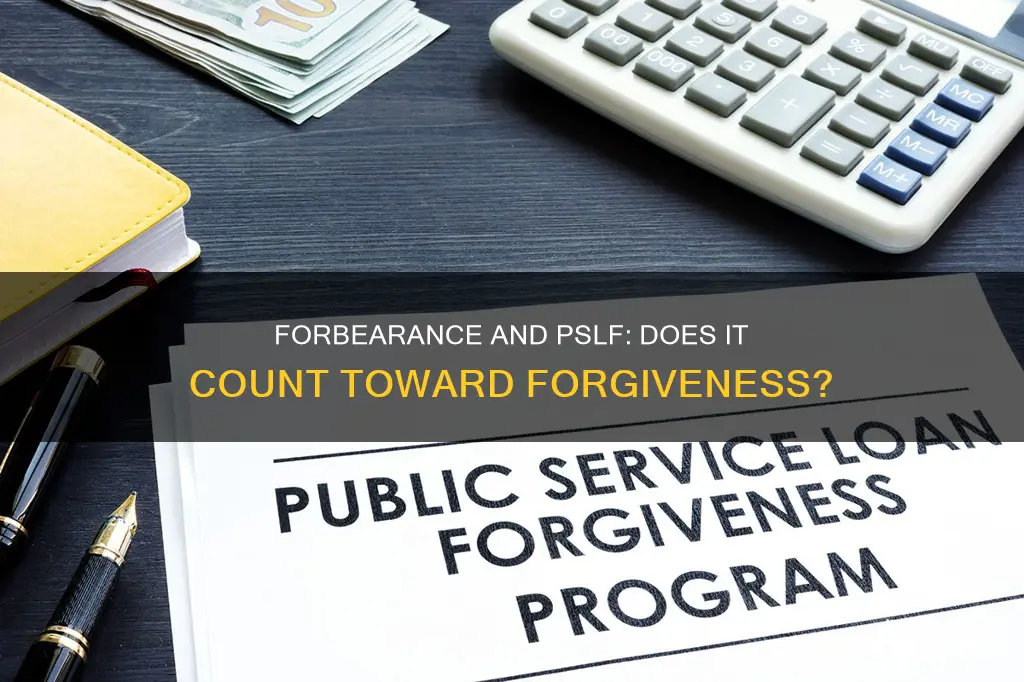
The Public Service Loan Forgiveness (PSLF) program is designed to forgive federal student loans after a borrower makes 120 qualifying payments while working full-time for an eligible employer, such as a government agency or a nonprofit organization. While forbearance can be a helpful tool for borrowers facing financial hardship, it is important to understand how it may impact your progress toward PSLF. Generally, forbearance periods do not count toward the 120 qualifying payments required for PSLF. However, there are some exceptions and temporary measures in place that borrowers should be aware of.
What You'll Learn
- Forbearance periods of 12+ months or 36+ months over the loan's life count towards PSLF
- PSLF Buyback lets borrowers submit a request to make payments for missed months
- Borrowers with Direct Loans and a PSLF application will automatically receive forbearance credits
- Borrowers with FFEL and Perkins Loans must consolidate into a Direct Loan and submit a PSLF form
- Active-duty military members who placed loans in deferment while serving can receive PSLF credit

Forbearance periods of 12+ months or 36+ months over the loan's life count towards PSLF
Forbearance periods can count towards the 120 qualifying payments required for Public Service Loan Forgiveness (PSLF), but only under specific conditions. These conditions are that the forbearance period must be at least 12 consecutive months or 36 cumulative months over the life of the loan. This is due to President Biden's one-time waivers and account adjustments, which allow borrowers, especially public servants, to receive PSLF credit for qualifying periods of forbearance.
The PSLF Buyback Program is another way for borrowers to have their forbearance months count towards loan forgiveness. This program allows borrowers to submit a request to make payments for missed months due to forbearance after reaching 120 months of qualified employment in a public service field. It is important to note that the forbearance due to the SAVE plan litigation does not automatically count towards PSLF, and borrowers may need to switch to an income-driven repayment plan to start making payments sooner.
Additionally, borrowers with Direct Loans who have submitted a PSLF application will automatically receive these forbearance credits without further action. However, borrowers with older loan types, such as Federal Family Education Loans (FFEL) and Perkins Loans, must consolidate their loans into a Direct Loan and submit a PSLF form to benefit from the forbearance credit.
It is crucial for borrowers pursuing PSLF to stay informed about their payment status and ensure they are making the right type of payments under an income-driven repayment plan or any other qualifying repayment plan while maintaining continuous employment with eligible employers.
LendingTree's Consolidation Loans: What You Need to Know
You may want to see also

PSLF Buyback lets borrowers submit a request to make payments for missed months
The Public Service Loan Forgiveness (PSLF) Buyback Program allows borrowers to "'buy" missing payments that would have qualified them for loan forgiveness. To qualify for the PSLF Buyback Program, borrowers must have 120 months of qualifying employment in a qualifying public service job and an outstanding student loan balance remaining.
The PSLF Buyback program is only available to borrowers who will complete a total of 120 qualifying PSLF payments when buying back months in forbearance or deferment. The buyback amount is a lump sum calculated based on what the borrower would have paid on an income-driven repayment plan during the months being bought back.
Borrowers can buy back months when they were in an ineligible deferment or forbearance status but were otherwise eligible for PSLF by making payments equivalent to what they would have paid under a qualifying payment plan during the deferment or forbearance period. To apply for the PSLF Buyback Program, borrowers should submit the PSLF Reconsideration Application and select "Incorrect Qualifying Payment Count." They should specify the start and end of the time period to be reconsidered and provide a statement indicating that they have at least 120 months of approved qualifying employment and are seeking PSLF or TEPSLF discharge through PSLF buyback.
It is important to note that there are limitations to the PSLF Buyback Program. Borrowers cannot buy back months when their loan was in certain statuses, such as during in-school deferment or during a grace period. Additionally, if loans have already been paid off, forgiven, or discharged, they are not eligible for the program.
Loan Income and Medicaid: Understanding the Complex Relationship
You may want to see also

Borrowers with Direct Loans and a PSLF application will automatically receive forbearance credits
Borrowers with Direct Loans who have submitted a PSLF application will automatically receive forbearance credits without needing to take further action. This is in addition to the loan forgiveness credits that federal student loan borrowers accumulated during the Covid-19 pandemic. The Covid-19 forbearance has added 29 months of credit towards PSLF and Income-Driven Repayment Plan forgiveness.
The PSLF Buyback Program allows borrowers to submit a request to make payments for the months they missed due to forbearance. This is applicable to borrowers who have reached 120 months of qualified employment in a public service field. For example, if a borrower had made 100 out of 120 payments as of July 2024, when those enrolled in the SAVE plan were put into forbearance, their 120th payment would be the last payment of the buyback.
It is important to note that the forbearance due to the SAVE plan litigation does not automatically count towards PSLF, unlike the forbearance during the Covid-19 pandemic. Borrowers who are enrolled in the SAVE repayment plan are expected to remain in forbearance for at least six months or longer.
To take advantage of the PSLF Buyback Program, borrowers must submit a new or updated Employment Certification Form (ECF) to prove their eligible employment. Once the eligible employment is reflected in their student account, they can complete the form requesting "Public Service Loan Forgiveness (PSLF) Reconsideration".
Loans and Income Statements: What's the Connection?
You may want to see also

Borrowers with FFEL and Perkins Loans must consolidate into a Direct Loan and submit a PSLF form
The Public Service Loan Forgiveness (PSLF) program is a US federal initiative that provides loan forgiveness to borrowers after they have made 120 qualifying payments. Borrowers with Federal Family Education Loans (FFEL) and Perkins Loans must consolidate their loans into a Direct Consolidation Loan to qualify for PSLF. This is because FFEL loans are considered older loan types that were made by private banks and state-based lenders but guaranteed by the federal government.
To consolidate their loans, borrowers can visit the Federal Student Aid website, studentaid.gov. By consolidating, borrowers can extend their repayment term by up to 30 years and access income-driven repayment plans. However, borrowers should be aware that consolidating can reset the forgiveness clock, causing them to lose credit for previous qualifying payments. Additionally, consolidating may result in a higher interest rate if borrowers lose any current interest rate discounts.
After consolidating their FFEL and Perkins Loans, borrowers must submit a PSLF form to MOHELA to benefit from the one-time account adjustment. This form is known as the PSLF Employment Certification Form, and it certifies the borrower's qualifying employment. Borrowers must submit this form for every full-time job held with the government or a non-profit organization from October 1, 2007, onwards.
It is important to note that borrowers who are in a deferment or forbearance status will not receive credit toward the 120 qualifying payments under the PSLF program. However, under specific conditions, forbearance periods of at least 12 consecutive months or 36 cumulative months over the life of the loan can count toward the 120 qualifying payments. The Department of Education has created the PSLF Buyback program, which allows borrowers to submit a request to make payments for missed months due to forbearance once they reach 120 months of qualified employment in a public service field.
Loan Depot's HELOC Options: What You Need to Know
You may want to see also

Active-duty military members who placed loans in deferment while serving can receive PSLF credit
Active-duty military members who placed their loans in deferment while serving can receive Public Service Loan Forgiveness (PSLF) credit for those periods. This is in addition to the loan forgiveness credits that federal student loan borrowers have been accumulating during the Covid-19 pandemic. The Covid-19 forbearance will have added 29 months of credit towards PSLF and Income-Driven Repayment Plan forgiveness by September 2022.
The PSLF waiver has been a success, writing off $8.1 billion in student debt for 145,000 borrowers. However, it has not been beneficial for parents with Parent PLUS Loans.
The Department of Education (ED) has created a program called "PSLF Buy Back" to allow borrowers to make up for missed payments due to forbearance. Once they reach 120 months of qualified employment in a public service field, they can submit a request to make payments for the months missed. This program is not limited to military members but applies to any borrower enrolled in PSLF who missed payments due to deferments or forbearance after 2007.
Additionally, under specific conditions, forbearance periods of at least 12 consecutive months or 36 cumulative months over the life of the loan can count toward the 120 qualifying payments required for PSLF. This is applicable to borrowers with Direct Loans who have submitted a PSLF application and will receive these forbearance credits automatically. On the other hand, borrowers with Federal Family Education Loans and Perkins Loans need to consolidate those loans into a Direct Consolidation Loan and submit the PSLF form to benefit from this adjustment.
LendingTree Boat Loans: What You Need to Know
You may want to see also
Frequently asked questions
Forbearance periods do not usually count towards the 120 qualifying payments needed for Public Service Loan Forgiveness (PSLF). However, under specific conditions, forbearance periods of at least 12 consecutive months or 36 cumulative months over the life of the loan can count towards PSLF.
To benefit from this one-time account adjustment, borrowers with Direct Loans must submit a PSLF application. Borrowers with Federal Family Education Loans and Perkins Loans must consolidate their loans into a Direct Consolidation Loan and submit the PSLF form.
The PSLF Buyback Program allows borrowers to submit a request to make payments for missed months due to forbearance once they reach 120 months of qualified employment in a public service field.







